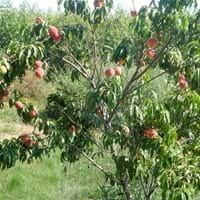Life Span
Perennial
Perennial
Type
Flowering Plants, Fruits, Trees
Fruit
Origin
Central America, Europe, North America
China
Types
Not Available
Tuscany, Royal Gem, Flavortop, Crimson Baby, Fantasia
Number of Varieties
Not Available
Habitat
Hedge, Scrubs, Woods
Warmer regions
USDA Hardiness Zone
4-8
5-9
AHS Heat Zone
Not Available
9-1
Sunset Zone
Not Available
H1, 1a, 1b, 2a, 2b, 3a, 3b, 6, 7, 8, 9, 10, 11, 12, 13, 14, 15, 16, 18, 19, 20, 21, 22, 23, 24
Habit
Not Available
Oval or Rounded
Flower Color
White
White, Red, Light Pink, Rose
Flower Color Modifier
Not Available
Bicolor
Fruit Color
Yellow
White, Yellow, Red, Pink, Peach
Leaf Color in Spring
Dark Green
Green
Leaf Color in Summer
Green
Green
Leaf Color in Fall
Brown, Green, Light Yellow
Green
Leaf Color in Winter
Not Available
Light Green
Leaf Shape
Oblong
Long, simple, curved and folded
Plant Season
Summer
Spring
Sunlight
Full Sun, Partial shade
Full Sun
Growth Rate
Medium
Medium
Type of Soil
Loamy
Loam, Sand
The pH of Soil
Neutral
Acidic, Neutral
Soil Drainage
Well drained
Well drained
Bloom Time
Fall, Summer
Spring
Tolerances
Drought
Drought
Where to Plant?
Ground
Ground
How to Plant?
Grafting, Seedlings, Transplanting
Budding, Grafting, Seedlings
Plant Maintenance
Medium
Medium
Watering Requirements
Medium
Average Water Needs, Requires regular watering
In Summer
Lots of watering
Lots of watering
In Spring
Moderate
Moderate
In Winter
Average Water
Average Water
Soil pH
Neutral
Acidic, Neutral
Soil Type
Loamy
Loam, Sand
Soil Drainage Capacity
Well drained
Well drained
Sun Exposure
Full Sun, Partial shade
Full Sun
Pruning
Prune when plant is dormant, Remove dead or diseased plant parts
Remove damaged leaves, Remove dead branches, Remove dead leaves
Fertilizers
All-Purpose Liquid Fertilizer
All-Purpose Liquid Fertilizer
Pests and Diseases
Aphids, Curculio occidentis, Japanese Beetles, Leaf Rollers, Leafminer, Mites, Red blotch, sawflies, Scale, Stink bugs
Red blotch
Plant Tolerance
Drought
Drought
Flower Petal Number
Single
Single
Fragrant Flower
Yes
Insignificant
Foliage Texture
Medium
Medium
Foliage Sheen
Matte
Glossy
Attracts
Not Available
Bees, Hummingbirds, Insects
Allergy
Digestive Problems, Respiratory problems
Anaphylaxis, Asthma, Bronchial-constrictions, Food Allergy, Urticaria
Aesthetic Uses
Showy Purposes
Beautification
Beauty Benefits
Beautiful Skin
Good for skin, Making cosmetics
Environmental Uses
Food for birds
Air purification
Medicinal Uses
Anthelmintic, Antibacterial, Astringent, Hypnotic, Laxative, Refrigerant
Aphrodisiac, Blood stasis and neurodegenerative diseases, Cancer, cholesterol-lowering, Combats Stress, Culinary Usage, Diuretic, Hair Loss, Hypokalemia, Obesity, Skin Disorders, Stomach pain, Weight loss
Part of Plant Used
Fruits
Bark, Flowers, Leaves, Seeds
Other Uses
Edible syrup, Jam, Jelly, Used As Food
For making oil, Gum, Used as a dye, Used as Ornamental plant
Used As Indoor Plant
No
No
Used As Outdoor Plant
Yes
Yes
Garden Design
Not Available
Container, Fruit / Fruit Tree, Topiary / Bonsai / Espalier
Botanical Name
Malus sylvestris
PRUNUS persica nectarine
Common Name
European crab apple
Nectarine, Hardy Red
In Hindi
european crab apple
आड़ू
In German
Der Holzapfel, Europäischer Wildapfel
Dwarf Nectarine
In French
Le Boquettier, le Pommier sauvage ou Pommier des bois
Dwarf Nectarine
In Spanish
Malus sylvestris, el Manzano silvestre, manzano silvestre europeo
Dwarf Nectarine
In Greek
Ευρωπαϊκή μήλο καβουριών
Dwarf Nectarine
In Portuguese
Malus sylvestris
Dwarf Nectarine
In Polish
Jabłoń dzika
Dwarf Nectarine
In Latin
european crab apple
Hardy Red
Phylum
Magnoliophyta
Magnoliophyta
Class
Magnoliopsida
Magnoliopsida
Clade
Angiosperms, Eudicots, Rosids
Angiosperms, Eudicots, Rosids
Tribe
Not Available
Not Available
Subfamily
Not Available
Not Available
Number of Species
Not Available
Not Available
Importance of European Crab Apple and Dwarf Nectarine
Want to have the most appropriate plant for your garden? You might want to know the importance of European Crab Apple and Dwarf Nectarine. Basically, these two plants vary in many aspects. Compare European Crab Apple and Dwarf Nectarine as they differ in many characteristics such as their life, care, benefits, facts, etc. Every gardener must at least have the slightest clue about the plants he wants to plant in his garden. Compare their benefits, which differ in many ways like facts and uses. The medicinal use of European Crab Apple is Anthelmintic, Antibacterial, Astringent, Hypnotic, Laxative and Refrigerant whereas of Dwarf Nectarine is Aphrodisiac, Blood stasis and neurodegenerative diseases, Cancer, cholesterol-lowering, Combats Stress, Culinary Usage, Diuretic, Hair Loss, Hypokalemia, Obesity, Skin Disorders, Stomach pain and Weight loss. European Crab Apple has beauty benefits as follows: Beautiful Skin while Dwarf Nectarine has beauty benefits as follows: Beautiful Skin.
Compare Facts of European Crab Apple vs Dwarf Nectarine
How to choose the best garden plant for your garden depending upon its facts? Here garden plant comparison will help you to solve this query. Compare the facts of European Crab Apple vs Dwarf Nectarine and know which one to choose. As garden plants have benefits and other uses, allergy is also a major drawback of plants for some people. Allergic reactions of European Crab Apple are Digestive Problems and Respiratory problems whereas of Dwarf Nectarine have Anaphylaxis, Asthma, Bronchial-constrictions, Food Allergy and Urticaria respectively. Having a fruit bearing plant in your garden can be a plus point of your garden. European Crab Apple has showy fruits and Dwarf Nectarine has showy fruits. Also European Crab Apple is flowering and Dwarf Nectarine is not flowering . You can compare European Crab Apple and Dwarf Nectarine facts and facts of other plants too.





